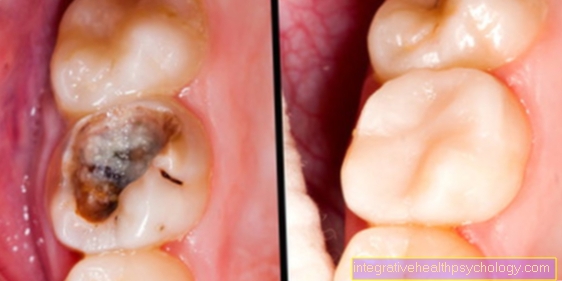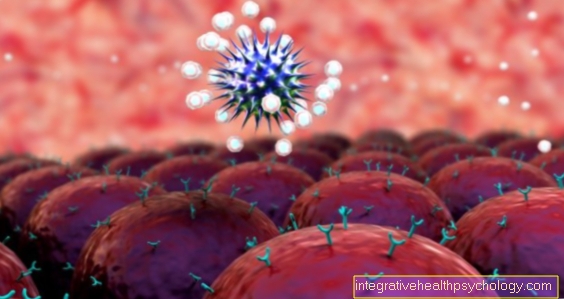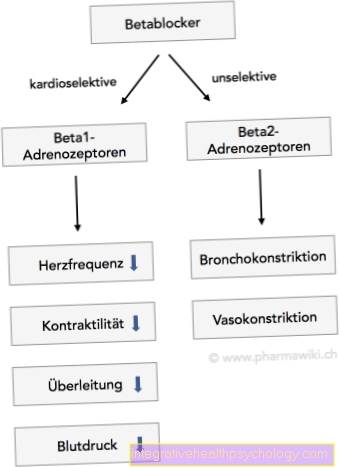How contagious is scarlet fever?
introduction
Scarlet fever is a highly contagious infectious disease that occurs primarily in childhood.
In community facilities such as schools and kindergartens, in particular, a real wave of illness breaks out.

Way of transmission of scarlet fever
The highly infectious pathogens, the so-called streptococci, are transmitted via droplets of saliva. When speaking or coughing, the droplets are released into the ambient air and can lodge in the mucous membranes of the contact persons who are still healthy and lead to an outbreak of scarlet fever. Contact with objects such as toys, glasses and toothbrushes from sick people also carries a high risk of infection.
People who are in direct contact with a sick person are exposed to a particularly high risk of infection. The incubation period is 2-4 days. During this time, those affected are already at risk of infection, although they usually do not show any symptoms themselves.
General information on the topic can be found at: Scarlet fever
Risk of infection for parents / adults
Since scarlet fever is a highly contagious infectious disease, there is a high risk of infection, especially for parents who are in close physical contact with their sick children on a daily basis. The disease-causing streptococci are found in the saliva of infected children. They get into the environment through sneezing or coughing and can implant themselves in the mucous membranes of healthy people. The risk of infection for parents and adults is particularly high if, for example, they use the same cutlery as their children.
In the case of scarlet fever, parents can minimize the risk of infection by avoiding intense physical contact with the child and making sure not to use items such as cutlery and glasses that are also used by the sick child.
Adequate hygiene should also be ensured, as this can prevent possible smear infections. Overall, however, the infection rate among parents or adults is significantly lower than among children, since most people have developed scarlet fever during their childhood and thus develop a certain immunity to the strain of the pathogen.
If they come into contact with the same strain of pathogen again in adulthood, they are destroyed very quickly by the body's own immune cells, so that the disease does not break out.
You might also be interested in: Complications of scarlet fever
Risk of infection for pregnant women
During pregnancy, women are much more at risk of contracting scarlet fever. The expectant mother's own immune system is particularly challenged during pregnancy and has to work harder. This means there is an increased risk of becoming infected with possible pathogens.
Read on this topic: Scarlet Fever in Pregnancy
Pregnant women are therefore advised to stay away from sick people as much as possible and to avoid contact with them. In order to reduce the risk of infection somewhat, pregnant women can take vitamins to strengthen and support their immune system.
If a pregnant woman falls ill with scarlet fever, the risk for the unborn baby is very low. So far, there are no known cases in which the unborn child has been harmed by scarlet fever in the mother. However, rapid antibiotic treatment (see also: Antibiotics) in order to avoid possible consequential damage such as heart or kidney damage in the expectant mother.
Read more on the subject at: How can you strengthen the immune system?
Risk of infection for children
The risk of infection with scarlet fever is particularly high in children. On the one hand, this is due to the fact that the child's immune system is still in the process of maturation and therefore not yet fully developed. If it comes into contact with pathogenic germs, these cannot yet be fought efficiently and an infection develops more quickly.
In addition, scarlet fever has an incubation period of 2 to 4 days. The sick children are already highly contagious, although they still feel well and do not yet show any specific symptoms.The risk of infection for children is particularly high in community facilities such as kindergartens, sports groups or schools, as they are in close physical contact with the other children.
Since the infection occurs via droplets of saliva, there is a high risk of infection, especially in public facilities. Playing and eating together makes a potential infection much easier.
Small children in particular often put objects or toys in their mouths. As part of a smear infection, the pathogens can then spread quickly through contact with contaminated objects and lead to an infection in the next child. Therefore, care should be taken to ensure that children suffering from scarlet fever do not visit public institutions such as schools or kindergartens as long as they are at risk of infection.
If a disease is known, adequate hygiene, especially hand washing, should also be observed in order to reduce the risk of smear infections.
Find out more about the various Symptoms of scarlet fever.
When can my child go back to kindergarten after scarlet fever?
Scarlet fever is mainly transmitted through saliva, for example in to cough and Sneeze, but can even be over shared items, such as toys in day-care centers. The risk of infection is particularly high in such community facilities. A child with scarlet fever can be contagious for up to three weeks without treatment. With adequate treatment, i.e. with antibiotics, the child is no longer contagious 24 hours after the start of treatment. In theory, kindergarten can then be attended again. However, since the child is often in a bad way, you should wait until the symptoms have disappeared.
The attending physician should also make the final decision on how long the child should stay at home. It is also important to report the child's infection to the kindergarten.
When can my child go back to school?
Schools are also part of the community facilities in which scarlet fever can spread easily due to the high risk of infection. Therefore, the same applies here as for attending kindergarten: 24 hours after the start of treatment with antibiotics, the child is no longer contagious. Nevertheless, you should wait until the symptoms are free in order to protect the child. In the case of schoolchildren, too, the doctor should make the final decision as to when school attendance is safe for the child and his classmates again.
How long are you contagious?
If a child suffers from scarlet fever, many parents ask themselves how long the risk of infection remains and what one should pay attention to in order to reduce it.
The length of the infection period depends largely on the start of medical therapy. If antibiotic therapy using a penicillin is initiated immediately in the case of scarlet fever, there is usually no more acute risk of infection after 24 hours.
Even if there is a significant decrease in symptoms and the person concerned feels better quickly, you should make sure, especially with children, that they stay at home for a few more days and recover properly. Antibiotic therapy and returning to kindergarten and school too quickly, combined with stress, can lead to an additional weakening of the immune system. In this context, complications or secondary illnesses may arise that further delay recovery.
If no antibiotic is administered, those affected are infectious for another 3 weeks and there is a risk of infection.
You might also be interested in: This is how long scarlet fever usually lasts
Are you contagious before symptoms start?
Scarlet fever is particularly dangerous when it comes to infection before the first typical symptoms appear. In contrast to many other infectious diseases, scarlet fever is not only contagious when the first symptoms such as a sore throat or rash manifest, but rather in advance when the sick feel well and have recovered.
It is precisely during this so-called incubation period, during which those affected are already infected by the bacteria, but the infection has not yet progressed far, that the greatest risk of infection exists. The incubation period can last 2 - 4 days and be completely asymptomatic for the sick. It is only after this time that the bacteria have properly embedded themselves in the mucous membranes of the sick and form the scarlet toxin (poison), which in turn leads to the typical skin rash accompanied by fever, sore throat and fatigue.
Also read: Scarlet fever test
Is scarlet fever contagious if you've already had it?
The scarlet pathogen Streptococcus Pyogenes is able to form toxins, the so-called toxins, of which three different are known so far. Scarlet fever will only develop if the respective type of streptococcus produces one of these toxins. After surviving the illness, the person is protected against this one toxin; but not against the other toxins. An infection with a pathogen that produces one of the other toxins is still possible. Thus, a one-time scarlet fever infection does not protect against another.
Read also: How often can you get scarlet fever?
How long will you be contagious if you take antibiotics?
As a rule, the risk of infection with scarlet fever begins 2 to 4 days before the onset of the first symptoms typical of the disease. According to this, there can already be a high risk of infection from those affected during this time.
According to medical guidelines, a disease with scarlet fever should always be treated with antibiotic therapy. Penicillin is prescribed as an antibiotic and should usually be taken for 7-10 days. It is important to take it consistently over the prescribed period, even if the child already feels significantly better and no longer shows any symptoms.
If antibiotic therapy is started quickly, there is usually no risk of infection after 1 - 2 days.
You may also be interested in this topic: Treatment of scarlet fever
How long are you contagious without antibiotics?
If scarlet fever is not treated with an antibiotic in accordance with current guidelines, not only does the risk of infection increase, but also the period in which those affected are infectious increases.
Without appropriate antibiotic therapy, there is a risk of infection for a total of up to 3 weeks. The typical symptoms of scarlet fever such as fever, sore throat and rash also last longer and those affected feel significantly worse overall and are very weak. Especially in adults, the symptoms can persist for several weeks or even several months without the use of adequate antibiotic therapy.
Also read: Vaccination against scarlet fever
Recommendations from our editorial team
- Symptoms of scarlet fever
- The scarlet tongue
- Scarlet fever rash
- Scarlet fever rash
- Duration of scarlet fever
- Scarlet fever in the baby















.jpg)













